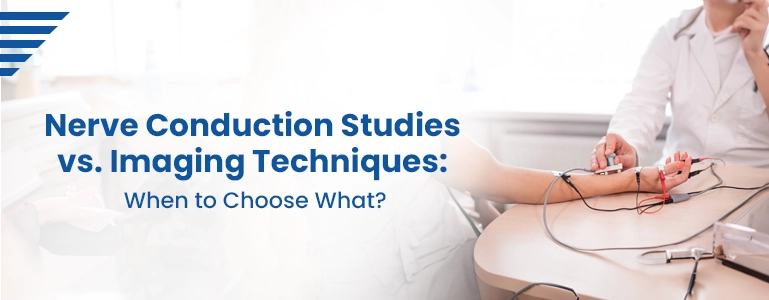Nerve Conduction Studies vs. Imaging Techniques: When to Choose What?

Medical diagnostics have evolved significantly over the years, offering a range of tools to help healthcare professionals pinpoint underlying health issues. When it comes to assessing nerve and muscle function, two primary methods stand out: Nerve Conduction Studies (NCS) and Imaging Techniques. In this blog, we'll delve into the differences between these approaches and guide you on when to choose one over the other for accurate diagnosis and treatment.
Nerve Conduction Studies (NCS)
Nerve Conduction Studies are non-invasive tests that assess the health and function of peripheral nerves. During an NCS, electrodes are placed on the skin over specific nerves. A mild electrical impulse is then delivered to the nerve, and the response is recorded. This provides valuable information about the nerve's ability to transmit signals, helping to identify conditions such as nerve damage, entrapment, and disorders like carpal tunnel syndrome.
When to Choose NCS:
Nerve Disorders : NCS is particularly effective for diagnosing conditions that involve nerve damage or dysfunction.
Specificity : NCS can pinpoint the location and extent of nerve damage, aiding in treatment planning.
Neuropathy : If you suspect peripheral neuropathy (nerve damage), NCS can confirm the diagnosis and provide insights into its severity.
Imaging Techniques
Imaging techniques like Magnetic Resonance Imaging (MRI) and Computed Tomography (CT) scans provide detailed images of internal structures. These techniques are widely used to visualize nerves, muscles, and other tissues. MRI uses strong magnetic fields and radio waves, while CT scans combine X-rays from various angles to create cross-sectional images.
When to Choose Imaging Techniques:
Structural Abnormalities : Imaging techniques are best for detecting structural changes, such as tumors, herniated discs, and anatomical irregularities.
Visualizing Soft Tissues : MRI and CT scans excel at visualizing soft tissues like muscles, tendons, and ligaments, providing a comprehensive view of the affected area.
Nerve Entrapment : Imaging can help identify nerve entrapment sites, allowing for precise planning of surgical interventions.
Making the Choice
The choice between NCS and imaging techniques depends on the suspected condition and the information needed for accurate diagnosis. Often, these methods complement each other:
Sequential Approach : In some cases, doctors might start with NCS to assess nerve function. If the results are inconclusive or suggest structural abnormalities, imaging techniques can provide additional insights.
Holistic Assessment : For a comprehensive understanding, both approaches might be employed to assess nerve function and detect any structural issues.
Conclusion
Nerve Conduction Studies and Imaging Techniques serve distinct purposes in diagnosing nerve and muscle-related conditions. NCS is valuable for assessing nerve function and identifying nerve-specific issues, while imaging techniques excel at visualizing anatomical structures and soft tissues. The choice between these methods depends on the specific condition, the clinical context, and the information needed for effective treatment. A collaborative approach between healthcare providers, specialists, and patients ensures that the most appropriate diagnostic path is chosen for optimal healthcare outcomes.
Frequently Asked Questions
What are Nerve Conduction Studies (NCS), and how do they differ from imaging techniques?
NCS involve electrical stimulation of nerves to assess their function, focusing on nerve health and signal transmission. Imaging techniques, like MRI and CT scans, create detailed images of anatomical structures and soft tissues, helping visualize abnormalities.
When should I consider Nerve Conduction Studies (NCS)?
NCS are suitable for diagnosing nerve-related issues, such as peripheral neuropathy, carpal tunnel syndrome, and nerve damage. They provide insights into how well nerves transmit signals.
When are Imaging Techniques more appropriate?
Imaging techniques are preferred when assessing structural abnormalities, like tumors, herniated discs, or anatomical irregularities. They excel at visualizing soft tissues and providing a comprehensive view of affected areas.
Can Nerve Conduction Studies and Imaging Techniques be used together?
Absolutely. These methods often complement each other. NCS might be the initial step to assess nerve function, and if needed, imaging can provide additional details about structural issues or anatomical abnormalities.
Which method is better for diagnosing nerve entrapment?
Imaging techniques, such as MRI, are excellent for identifying nerve entrapment sites and visualizing the surrounding structures. They can aid in pinpointing the cause of nerve compression.
Are Nerve Conduction Studies painful?
NCS involve mild electrical impulses, which can cause some discomfort but are generally well-tolerated. The sensation is often described as a brief tingling or mild shock.
How do healthcare professionals decide between Nerve Conduction Studies and Imaging Techniques?
The choice depends on the suspected condition and the information needed for accurate diagnosis. Healthcare providers might opt for NCS to assess nerve function and then use imaging techniques to visualize structures and tissues for a comprehensive evaluation.
Book Appointment
Our Locations Near You in Hyderabad
3KM from Banjara Hills
1.9KM from Yusufguda
3KM from Madhura Nagar
5KM from Shaikpet